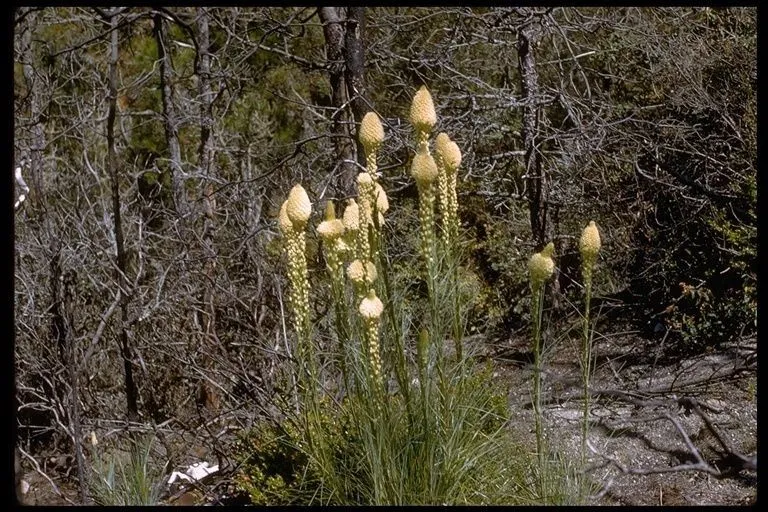
Author: (Pursh) Nutt.
Bibliography: Gen. N. Amer. Pl. 1: 235 (1818)
Year: 1818
Status: accepted
Rank: species
Genus: Xerophyllum
Vegetable: False
Observations: W. Canada to N. California
Bear-grass, known scientifically as Xerophyllum tenax, is a captivating plant species that belongs to the Melanthiaceae family. Native to a broad range stretching from Western Canada down through Northern California, this plant has captured the fascination of botanists and nature enthusiasts alike.
Described in the early 19th century by Frederick Traugott Pursh and later classified by Thomas Nuttall, the plant was formally recorded in the publication “Genera of North American Plants” in 1818. This historical documentation highlights the enduring significance of Bear-grass within the botanical community.
The plant typically thrives in environments found in its native range, often adapting to the specific conditions prevalent in mountainous regions and forested areas. Bear-grass is well-known for its striking appearance. It features long, grass-like leaves that form dense tufts, which are both resilient and flexible, a characteristic that earns it the common name “Bear-grass.”
During its blooming period, Bear-grass produces a distinctive and visually appealing floral display. Tall, unbranched stems rise dramatically above the foliage, culminating in clusters of small, white flowers. These flowers not only add a unique aesthetic value to the plant but also play a crucial role in the local ecosystem, attracting pollinators and contributing to the biodiversity of their habitats.
Historically, Bear-grass has also been significant to indigenous cultures within its range. The plant’s durable leaves were traditionally harvested and utilized to weave baskets and other items due to their strong, fibrous nature.
In summary, Xerophyllum tenax, or Bear-grass, is a notable species recognized for its unique structural beauty and adaptability. It stands as a testament to the rich botanical heritage of North America, marked by its historical classification and long-standing utilitarian use. Whether observed in the wild or studied for its ecological importance, Bear-grass continues to be a plant of both practical and scientific interest.
Eng: indian basket-grass, bear-grass, bear-lily, common beargrass, elk-grass, fire-lily, western turkey-beard, beargrass, indian basketgrass, elkgrass
Swe: björnlilja
Fra: xérophylle de l’ouest, xérophylle
En: Bear-grass, Bear-lily, Fire-lily, Indian basket-grass, Western turkey-beard, Elk-grass, Common beargrass, Beargrass, Indian basketgrass, Elkgrass
Fr: Xérophylle de l’Ouest, Xérophylle
Sv: Björnlilja
Taken Nov 7, 2008 by EOL − Keir Morse (cc-by-nc-sa)
Taken Nov 7, 2008 by EOL − Keir Morse (cc-by-nc-sa)
Taken Dec 11, 2002 by EOL − Gary A. Monroe (cc-by-nc)
Taken Feb 24, 1999 by EOL − Beatrice F. Howitt (cc-by-nc-sa)
Taken Jul 9, 2022 by Sandra Robinson (cc-by-sa)
Taken Jul 4, 2022 by Christine Cox (cc-by-sa)
Taken Jun 15, 2019 by Michael Finch (cc-by-sa)
Taken Jun 21, 2021 by Kris Aleks (cc-by-sa)
Taken Jun 22, 2020 by Evan VanSandt (cc-by-sa)
Taken May 9, 2021 by Zek Nomad (cc-by-sa)
Taken Jul 4, 2019 by Randy (cc-by-sa)
Taken May 5, 2022 by gene (cc-by-sa)
Taken Jul 9, 2022 by Sandra Robinson (cc-by-sa)
Taken Apr 5, 2020 by Géraldine Marck (cc-by-sa)
Taken Sep 2, 2014 by EOL − John Brew (cc-by-sa)
Taken Dec 1, 1998 by EOL − Charles Webber (cc-by-nc-sa)
Taken Dec 1, 1998 by EOL − Charles Webber (cc-by-nc-sa)
© copyright of the Board of Trustees of the Royal Botanic Gardens, Kew.
Growth form>: Rhizomatous
Growth habit>: Forb/herb
Growth rate>: Rapid
Ph maximum: 7.2
Ph minimum: 5.5
Family: Myrtaceae Author: (F.Muell.) K.D.Hill & L.A.S.Johnson Bibliography: Telopea 6: 402 (1995) Year: 1995 Status:…
Family: Rubiaceae Author: Pierre ex A.Froehner Bibliography: Notizbl. Bot. Gart. Berlin-Dahlem 1: 237 (1897) Year:…
Family: Sapindaceae Author: Koidz. Bibliography: J. Coll. Sci. Imp. Univ. Tokyo 32(1): 38 (1911) Year:…
Family: Asteraceae Author: A.Gray Bibliography: Pacif. Railr. Rep.: 107 (1857) Year: 1857 Status: accepted Rank:…
Family: Fabaceae Author: Medik. Bibliography: Vorles. Churpfälz. Phys.-Ökon. Ges. 2: 398 (1787) Year: 1787 Status:…
Family: Aspleniaceae Author: (Cav.) Alston Bibliography: Bull. Misc. Inform. Kew 1932: 309 (1932) Year: 1932…